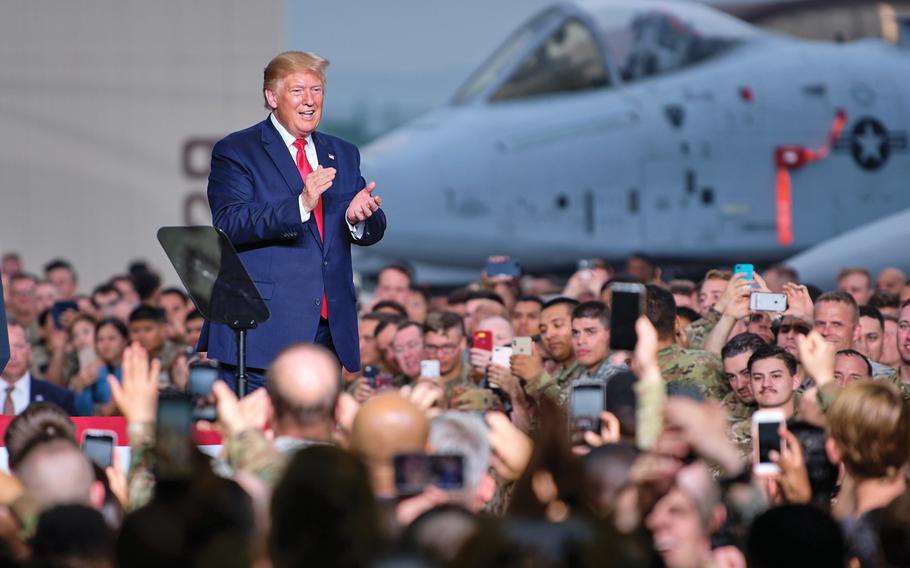
Then-President Donald Trump applauds service members and families during a 2019 speech at Osan Air Base, South Korea. In an interview this week, Trump gave his thoughts about using troops on the U.S. southern border and what relations with South Korea and NATO would be like if he wins a second term. (Stars and Stripes)
Republican presumptive presidential nominee Donald Trump is open to using active-duty military personnel at the U.S. southern border, where he envisions carrying out the largest deportation operation in American history, he said this week.
“I can see myself using the National Guard, and if necessary, I’d have to go a step further,” the former president said in an interview with Time magazine published Tuesday. “We have to do whatever we have to do to stop the problem we have.”
Trump didn’t detail exactly what would trigger the involvement of the military or how he would work around legal restrictions on using federal troops for law enforcement inside the United States.
But his comments during the wide-ranging interview indicated that a second Trump term would have significant implications for American service members stationed both at home and abroad.
The arrival of millions of immigrants across the southern border during President Joe Biden’s tenure has been a focal point of Trump’s campaign.
While the situation has strained border communities, it also has challenged faraway cities such as New York and Chicago, where immigrants have been relocated.
Trump said he intends to focus less on building detention camps to house migrants and more on using local law enforcement, the National Guard and possibly the active-duty armed forces to assist in deportation operations.
When asked about U.S. military involvement, Trump told Time, “I would have no problem using the military, per se.”
The Posse Comitatus Act states that a president can’t deploy the federal troops for civilian law enforcement without express statutory authority. But Trump indicated that he regards immigrants differently.
“Well, these aren’t civilians,” he said. “These are people that aren’t legally in our country. This is an invasion of our country. ... We’re not leaving them in the country. We’re bringing them out.”
A bill with earlier bipartisan support in Congress that sought to adjudicate immigration cases more quickly, among other measures, was scuttled earlier this year after Trump spoke out against it.
Trump also reiterated long-standing criticisms of U.S. alliances overseas and indicated that he could consider changes in how forces are based abroad.
“I think we have a lot of options, and I think we’re in a lot of places where we shouldn’t be, and we probably aren’t in some places where we should be,” Trump said without elaborating.
“We have a lot of options as to troops,” he continued. “And one of the things we have, we can manage our expectations, troops can be put in certain locations very quickly.
When asked whether he would pull U.S. forces out of South Korea, Trump didn’t give a clear answer but said he would expect South Korea to spend more to support the personnel that are there.
U.S. troops are “in a precarious position” given their proximity to North Korea, he said. While Trump has touted his friendly relationship with North Korean leader Kim Jong Un, he said the dictator is “a man who nevertheless, he’s got visions of things.”
Regarding NATO, Trump again complained that allies don’t spend enough on defense. Still, much in NATO has changed since Trump was president.
In 2016, only a handful of allies hit the NATO benchmark that calls for spending 2% of gross domestic product on defense.
Now, about 20 countries in the 32-member alliance are expected to hit the mark ahead of an alliance summit in July. U.S. officials have said most of the remaining members plan to hit the target in later years.
When asked whether he wanted to maintain the U.S.’s position in NATO, which has served as the linchpin for American security strategy in the West since the end of World War II, Trump’s comments were mixed.
“I want them to pay their bills, very simple,” he said. “NATO is fine. See, the problem I have with NATO is I don’t think that NATO would come to our defense if we had a problem. ... I know them all. It’s a one-way street, even if they paid.”
The only time NATO has ever invoked its bedrock Article 5 provision, that an attack on one is an attack on all, came after the terrorist attacks of Sept. 11, 2001.
In the years that followed, thousands of NATO troops fought alongside U.S. personnel in Afghanistan, in what turned out to be America’s longest war in history.